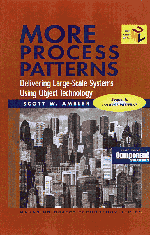Book contents
- Frontmatter
- About the Author
- Contents
- Illustrations
- Abbreviations
- Foreword
- Preface
- Chapter 1 Introduction to More Process Patterns
- Part 1 Deliver
- Part 2 Maintain and Support
- Chapter 7 The Maintain and Support Phase
- Chapter 8 The Support Stage
- Chapter 9 The Identify Defects and Enhancements Stage
- Part 3 Tying Up Loose Ends
- Glossary
- Index
Chapter 7 - The Maintain and Support Phase
from Part 2 - Maintain and Support
Published online by Cambridge University Press: 04 August 2010
- Frontmatter
- About the Author
- Contents
- Illustrations
- Abbreviations
- Foreword
- Preface
- Chapter 1 Introduction to More Process Patterns
- Part 1 Deliver
- Part 2 Maintain and Support
- Chapter 7 The Maintain and Support Phase
- Chapter 8 The Support Stage
- Chapter 9 The Identify Defects and Enhancements Stage
- Part 3 Tying Up Loose Ends
- Glossary
- Index
Summary
THE goal of the Maintain and Support phase, the fourth serial phase of the object-oriented software process (OOSP), is to keep your application running in production and to ensure that changes to the application are identified and acted on appropriately. Common forces applicable to this stage are the unwillingness of senior management to adequately fund maintenance and support efforts, the unwillingness of “hard-core” developers to perform maintenance activities (or to even recognize their importance), and the difficulty of finding and retaining support staff.
The process pattern depicted in Figure 7.1 shows that the Maintain and Support phase is comprised of two stages: the Support stage (Chapter 8) and the Identify Defects and Enhancements stage (Chapter 9). The Maintain and Support phase begins for an application after it has been successfully delivered to your customers—your user, support, and operations communities. The main output of this phase is a series of maintenance changes that have been allocated to the configuration items (CIs) that make up your application, changes that are accompanied by the software problem reports (SPRs), and software change requests (SCRs) from which they were generated.
The purpose of the Support stage is to respond to incoming support requests from users; to identify a resolution for the issue; and then to oversee the implementation of that resolution.
- Type
- Chapter
- Information
- More Process PatternsDelivering Large-Scale Systems Using Object Technology, pp. 149 - 162Publisher: Cambridge University PressPrint publication year: 1999

